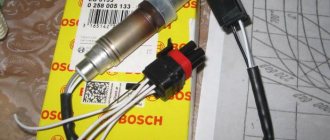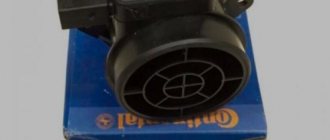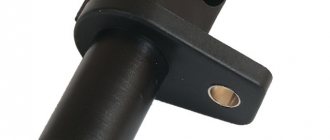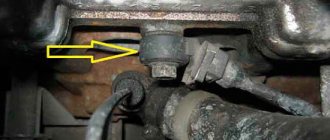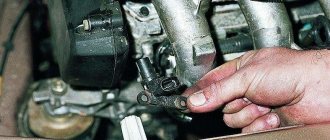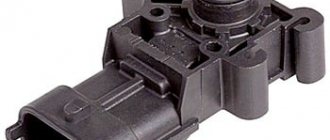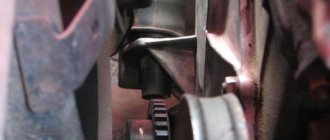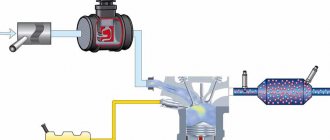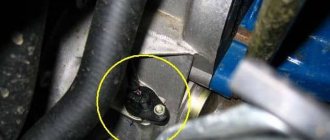The mass air flow sensor is used to estimate and balance the air flow entering the engine. Signals from the device are sent to the motor control unit. Based on data from the mass air flow sensor and other sensors, the required mixture composition is formed. To prevent the device from breaking down on the road, it is necessary to diagnose it. There are several ways to check the mass air flow sensor on a VAZ 2114.
DMVR device on VAZ 2114
The overall design of the sensor consists of two filaments made of a platinum-based alloy. The threads are heated by electric current, with one being the working thread and the other being the control thread. The working element is located in the air flow supplied to the engine, which cools the part. As the temperature of the filament changes, resistance increases or decreases. The data is compared with the parameters of the control element, and based on this, the amount of air passed is automatically calculated.
On later VAZ 2114 models, thermistors began to be used, which have increased durability and measurement accuracy. This is exactly the sensor that is used on the VAZ 2114.
Where is the mass air flow sensor located?
The mass air flow sensor on the VAZ 2114 is located in the air duct located behind the air purification filter. A wiring harness is connected to the sensor, ending with a plug.
Installation location of the air flow sensor on the VAZ 2114 engine
Sensor design features
The VAZ 2114 can use mass air flow sensors of domestic and imported origin. The design of the devices is the same and corresponds to the diagram below.
Design of the air flow sensor VAZ 2114
The DMRV includes:
- 1 — block for connecting the wiring harness;
- 2 — sensor operation controller;
- 3 - measuring element;
- 4 — outer body;
- 5 — metal protective mesh;
- 6 — guide deflector;
- 7 — fastening the sensor body to the body;
- 8 — direction of air flow.
Design
The sensor is a cylindrical part made of special plastic that is resistant to high temperatures. The body of the sensor contains a special sensitive element that counts the amount of air entering the combustion chamber of the engine. A special mesh is installed in front of this element, which prevents the entry of large debris that can damage not only the sensor, but also the internal combustion engine itself.
The sensor has a connector for connecting a control circuit with 4 pins. The connector is connected to the sensor on one side, and on the other to the engine control unit.
What is the optimal air flow for VAZ 2114 cars?
The amount of air required to form the mixture depends on the speed:
- at idle speed (850-950 rpm) - 9.5-10.5 kg of air per hour;
- at medium speed (2000 rpm) - 19-21 kg of air per hour.
Reducing the air supply leads to a leaner mixture, and increasing it leads to a richer mixture. Small deviations in measurement accuracy have little effect on the operation of the engine, but with errors of 2-3 kg, the engine begins to operate unstably. Some control units compensate for measurement inaccuracies based on data from other sensors. For example, the January 5.1 block additionally adjusts the mixture composition based on the signal from the lambda probe.
The main causes of failure of the mass air flow sensor
The most common causes of sensor failure are:
- dust ingress;
- oil contamination;
- short circuit of the wiring due to damage to the insulation or plug;
- mechanical damage to active elements.
A common cause of incorrect operation of the mass air flow sensor is the failure of electronic components, which increases the sensor’s response time to changes in air flow. A working sensor monitors changes at a speed of 0.5 ms, and if it breaks down, the response time increases by 20-30 times. The defect is detected only by recording the operation graph with an oscilloscope. Such a sensor cannot be repaired; it must be replaced with a new one.
What factors disable the mass air flow sensor?
Factors causing failure of the air flow sensor:
- Dust may be caused by improper installation of the sensor on the filter, which causes the sealing ring to become distorted. With this defect, a thin coating of contamination will be present on the sensor input grid. Another cause of dust is a clogged air filter, so regular maintenance will prolong the life of the air flow sensor.
- Oil is thrown onto the sensor if the level in the crankcase is high or if the oil separator in the ventilation system is clogged. An additional negative factor is engine wear, which causes lubricant to actively enter the crankcase ventilation.
- Contact with sharp objects on the insulation, oiling. Such impacts are the result of careless repairs.
- Damage to the sensor is possible during vehicle maintenance (impacts to the body) or during improper cleaning of the active part.
Causes of malfunctions
In 90% of cases, this is contamination of sensitive sensors.
- a low-quality (not certified) or incorrectly installed air filter allows dust to enter the mass air flow sensor measuring channel;
- when operating the vehicle in wet weather or driving through puddles, droplets of water may enter the intake manifold;
- If the crankcase ventilation system does not work (damaged hoses, broken valve), drops of oil enter the air duct pipe.
A dirty sensor can be cleaned or even washed.
Important! Mechanical impact (brushes, cotton swabs) and the use of aggressive agents (acetone, gasoline) are not allowed.
For small amounts of dirt, blowing with compressed air is sufficient. If the air attack does not help, use a special aerosol cleaner for carburetors and mass air flow sensors.
Before reinstallation, the flowmeter must be allowed to dry in the open air.
How to check the mass air flow sensor yourself?
To independently check the sensor, there are several methods based on disconnection, as well as inspection and testing with a multimeter. There are no other diagnostic methods at home. A thorough inspection of the mass air flow sensor is carried out on a special stand, which makes it possible to record sensor problems under various operating modes. Another common testing method is to install an identical device removed from another vehicle.
Disabling the mass air flow sensor
The easiest way to check the mass air flow sensor on a VAZ 2114 is to disconnect the plug. If there is no signal, the engine control unit goes into emergency operation mode, determining the approximate air volume based on the throttle position. At the same time, fuel consumption increases slightly - for the VAZ 2114 it reaches 10-12 liters per 100 km. A characteristic feature is the increase in idle speed to 1500 rpm. But when using the controller January 7.2. or Bosch M7.9.7 the increase in idle speed is not carried out due to the features of the software.
How to restore the mass air flow sensor?
The optimal solution for problems with the mass air flow sensor is to replace the faulty sensor with a new one. But since the cost of the device is about 2500-3900 rubles, many owners are trying to “revive” the old part.
There are four recovery methods:
- installation of additional resistance;
- blocking part of the air supply channel to the thermistor with aluminum tape;
- updating the engine control unit firmware;
- washing the sensor body and housing from dirt.
Installing additional resistance
Additional resistances are installed in the circuit connecting the sensor to the control unit. When an electric current passes, the voltage decreases, which can be brought to the required limits. The resistance value is selected experimentally. Most often, a 1 kOhm resistor is soldered to the yellow wire and a 15 kOhm element to the green wire.
Blocking part of the air supply channel
The repair principle is based on partially cutting off the air supply to the thermistor. Due to this, less intensive cooling is ensured and it is possible to bring the voltage value to the state of a working device. The cross section is selected experimentally with voltage monitoring using a multimeter. In some cases, owners block the supply channel by 70-80%. Aluminum tape is used for gluing.
Correcting the firmware of the engine control unit
An adjustment means a change in the calibration or operating schedule of the mass air flow sensor stored in the unit’s memory. The dependence graph is constructed in such a way that at a sensor voltage of 0.996 volts, the flow rate is considered equal to zero. But if the sensor fails and the starting voltage is 1.055 volts, then the control unit considers the air supply to be 1.8 kg when the engine is not running. Changing the graph using the MAF Corrector utility will allow you to set the flow rate to 0, which will improve engine performance. This method can be recommended to owners who are well versed in the control unit software.
Do-it-yourself cleaning of the air flow sensor
The air volume sensor is cleaned after it is detected that it is not working correctly. The procedure is performed by partially disassembling and removing the device body with active elements. At the same time, the body is washed and cleaned from remaining leaves and dirt deposits. In many cases, washing the air flow sensor on a VAZ 2114 does not help restore the device’s parameters.
Mechanical methods of cleaning the mass air flow sensor on the VAZ 2114 are prohibited, as is blowing dust with compressed air.
What products should be used to clean the sensor?
To clean sensors, there are special liquids supplied in pressurized aerosol cans. An example of such a product is a special air flow sensor cleaner Luftmassensor-Reiniger from Liqui Moly. There are similar liquids from other manufacturers. You can wash the sensor with a mixture of 70% isopropyl alcohol and 30% distilled water, after warming the device to 60-70 ºС with a hair dryer.
When washing the mass flow sensor it is prohibited:
- try to clean the sensor with cotton balls, hard objects and brushes;
- use household cleaning products;
- Use carburetor cleaners based on acetone or ether.
Cleaners based on heavy petroleum products, for example, WD40, will remove plaque from working parts, but will leave a greasy film that must be washed off with isopropyl alcohol. The use of ether-containing substances is not recommended due to the destruction of the compound filling and electronic components.
Algorithm of actions
Sequence of steps when washing the mass air flow sensor:
- Remove the sensor together with the housing from the engine air duct. The device is attached with a clamp to the channel and two bolts to the air filter housing.
- Unscrew the two screws securing the sensor to the housing. The bolts have a star head, but many owners unscrew them with pliers.
- Wash the measuring thermistors and the air passage channels with a cleaning agent. If the cleaning method with alcohol is used, the removed sensor is heated with a stream of warm air and placed in a container. The alcohol-water mixture is also heated to 60-70 degrees.
- Dry the sensor.
- Wash the sensor housing with warm soapy water. Rinse under running water and dry.
- Assemble the sensor and install it in place.
Photo gallery
The photographs show some of the steps for flushing the air flow sensor of a VAZ 2114.
DMVR device on VAZ-2114
General view of the DMVR sensor
Before proceeding directly to diagnostics, you need to know the design features and structure of this sensor. Let's look at the diagram of the DMVR device in the image.
DMVR device diagram
Causes of sensor malfunction
The next step before diagnosis is to identify the causes of the malfunction, as well as factors that may influence the mass air flow sensor to fail.
Check Engine icon on instrument panel
The first signal that the car is starting to have problems with the sensor is the appearance of the “Check Engine” indicator.
In this case, if you connect to the electronic engine control unit, you can identify the following malfunction: “ Insufficient MAF signal level .” This is what means that the sensor has failed.
Main features
So, let's look at the main signs of a malfunction of the DMVR:
- Malfunctions in the operation of the main power unit , namely: floating speed, the car stalls at idle.
- A drop in acceleration dynamics is also one of the fundamental factors in the interruption of operation of a given unit.
- When changing gears, the car simply stalls .
- Increased fuel consumption. This is due to the fact that the fuel mixture ratio is incorrect.
Now that the signs of a malfunction are clear, we can consider the factors that cause the failure of the DMVR:
- Destruction or breakage of wiring inside the product.
- Loose fixation of the wire block.
- Damage to the inside of the element.
- Oxidation of contacts.
- Wear or burnout due to short circuit.
Often the air flow sensor fails after washing the engine.
Checking the mass air flow sensor using a multimeter
In order to check the mass air flow sensor, it is not necessary to go to a car service center and spend a lot of time and money. To do this, you need a regular tester or multimeter , which can be bought for 300 rubles on the market.
Location of the DMVR sensor
To check the DMVR, you need to know the pinout of the contact group.
So, let's look at the pinout of the mass air flow sensor:
- Contact No. 5 (in Bosch sensors, as a rule, yellow wires come from it) - is responsible for supplying an incoming signal from the ECU;
- Contact No. 4 (gray or white) - is responsible for powering the device;
- Contact No. 3 (green wire) is responsible for grounding;
- Contact No. 2 (pink-black) is the wire through which information from the sensor is transmitted to the main relay of the fourteenth.
To determine serviceability, you do not need to remove the sensor. The multimeter is set to measure direct current up to 20 volts. Next, follow the step-by-step instructions:
The principle of checking the DMVR sensor
- We connect the red wire from the multimeter to pin 5, and the black wire to pin 3.
You can connect contacts using a pin
- Without starting the car, turn the ignition.
- We look at the multimeter readings, the explanation of which is given below.
| Tester readings (voltage, V) | Air flow sensor condition |
| 0.006 – 1.01 | Only new sensors produce this voltage; after several weeks of operation it increases by several hundredths; |
| 1.01 – 1.02 | Normal operating voltage of a device in constant operation; |
| 1.03 – 1.04 | The device has used up approximately half of its working resource; |
| 1.04 – 1.05 | The MAF voltage is in an extremely worn condition, replacement is recommended; |
| Above 1.05 | Such a sensor does not work, or it works but sends distorted signals to the ECU. |
Depending on the readings and interpretation, we carry out the appropriate repair operations.
Price
We remind you that this sensor is the most expensive of all sensors, its cost ranges from 1500 to 4000 depending on the model.
Home→Catalog→Engine→Power system→Max air flow sensor→Max air flow sensor VAZ-2110,1118,2170, 2123, 21214 1.6 l. (BOSCH) (116) (company packaging LADA)Characteristics
| Supplier code: | 175075 |
| Vendor code: | 21083-1130010-20 |
| Manufacturer: | Lada-Image CJSC |
MAF VAZ-2110,1118,2170, 2123, 21214 1.6 l. (BOSCH) (116) (branded packaging LADA) In stock ( 10 )4,575 RUR + 137.25 to the bonus account MAF VAZ-1118,2170 with email pedal (BOSCH) (branded packaging LADA) MAF VAZ-1118,2170 with el. pedal (BOSCH) (company packaging LADA)Characteristics
| Supplier code: | 155868 |
| Vendor code: | 21700-1130010-00 |
| Requisites: | Product, Product, 00-00001667, DMRV VAZ-1118,2170 with el. pedal (BOSCH) (original packaging LADA), 0.23 |
| Basic unit: | PC |
| Tax rates: | Tax free |
| Manufacturer: | BOSCH |
DMRV VAZ-1118,2170 with el. pedal (BOSCH) (branded packaging LADA) Out of stock RUB 3,430 + 102.9 to the bonus account MAF VAZ-2113-15, 1118-19, 2170, 21214-2123 (from 2005 onwards) Euro 2.3 Pekar MAF VAZ-2113-15,1118-19,2170,21214-2123 (from 2005 onwards) Euro 2.3 PekarCharacteristics
| Supplier code: | 171268 |
| Vendor code: | 21083-1130010-20 |
| Requisites: | Product, Product, 00-00036261, DMRV VAZ-2113-15,1118-19,2170,21214-2123 (since 2005) Euro 2.3 Pekar, 0.31 |
| Basic unit: | PC |
| Tax rates: | 18 |
| Manufacturer: | Fuel systems LLC Pekar |
MAF VAZ-2113-15,1118-19,2170,21214-2123 (from 2005 onwards) Euro 2.3 Pekar In stock (5)3,035 rub.+ 91.05 to the bonus account MAF VAZ-2108-99, 2113-15,2110-12 (1999-2004 onwards) Euro 2 PekarDFMRV VAZ-2108-99,2113-15,2110-12 (1999-2004 onwards) Euro 2 PekarCharacteristics
| Supplier code: | 171267 |
| Vendor code: | 2108-3-1130010-01 |
| Requisites: | Product, Product, 00-00019121, DMRV VAZ-2108-99,2113-15,2110-12 (1999-2004 onwards) Euro 2 Pekar, 0.29 |
| Basic unit: | PC |
| Tax rates: | 18 |
| Manufacturer: | Fuel systems LLC Pekar |
MAF VAZ-2108-99,2113-15,2110-12 (1999-2004 onwards) Euro 2 Pekar In stock ( 2 )2,975 RUR + 89.25 to the bonus account MAF VAZ-2110-12 engineer, VAZ -2123 (eng. 1.5 l.) (BOSCH) (037) (company packaging LADA) MAF VAZ-2110-12 engineer, VAZ-2123 (dv. 1.5 l.) (BOSCH) (037 ) (company packaging LADA)Characteristics
| Supplier code: | 200027 |
| Vendor code: | 21083-1130010-10 |
| Requisites: | Product, Product, 00-00036259, DMRV VAZ-2108-99,2113-15,2110-12,2123 (1999-2004 onwards) Pekar, 0.31 |
| Basic unit: | PC |
| Tax rates: | 18 |
| Manufacturer: | Lada-Image CJSC |
MAF VAZ-2110-12 engineer, VAZ-2123 (1.5 l.) (BOSCH) (037) (branded packaging LADA) In stock ( 10 ) RUR 5,145 + 154.35 to the VAZ MAF bonus account -1118,2170,2123 doors 1.6 16 cells. Priora BOSCHCharacteristics
| Supplier code: | 220569 |
| Vendor code: | 0280218225 |
| Manufacturer: | BOSCH |
DMRV VAZ-1118,2170,2123 doors 1.6 16 cells. Priora BOSCH In stock (2) RUR 3,520 + 105.6 to the bonus account MAF VAZ-2110-15, 2121 (doors 1,7), 2111 s.o. injector (BOSCH) (004) (company packaging LADA) 0280218004 DMRV VAZ-2110-15.2121 (eng. 1.7), 2111 s.o. injector (BOSCH) (004) (original packaging LADA) 0280218004Characteristics
- VAZ 2109: replacing the main brake cylinder on your own
| Supplier code: | 198982 |
| Vendor code: | 21120-1130010-82 |
| Requisites: | Product, Product, 00-00001670, DMRV VAZ-2110-15,2121 (doors 1,7), 2111 s.o. injector “BOSCH” (company packaging LADA), 0.29 |
| Basic unit: | PC |
| Tax rates: | Tax free |
| Manufacturer: | Lada-Image CJSC |
DMRV VAZ-2110-15.2121 (engine 1.7), 2111 s.o. injector (BOSCH) (004) (company packaging LADA) 0280218004 In stock ( 10 ) 8,290 RUR + 248.7 to the bonus account MAF door 405, 406 G-24-31105, G-3302, VAZ-2110-12 engineer, VAZ-2123 (1.5 l.) UAZ-3160 BOSCHCharacteristics
| Supplier code: | 030534 |
| Vendor code: | 0280218037 |
| Manufacturer: | BOSCH |
DMRV dv.405, 406 G-24-31105, G-3302, VAZ-2110-12 engineer, VAZ-2123 (dv.1.5 l.) UAZ-3160 BOSCH In stock (5)4,490 rub. + 134.7 to the bonus account MAF VAZ-2110,1118,2170, 2123, 21214 (1.6 l.) (Kaluga) MAF VAZ-2110,1118,2170, 2123, 21214 (1.6 l.) ( Kaluga)Characteristics
| Supplier code: | 098516 |
| Vendor code: | DMRV-116 |
| Basic unit: | PC |
| Manufacturer: | AUTOTRADE LLC |
MAF VAZ-2110,1118,2170, 2123, 21214 (1.6 l.) (Kaluga) In stock ( 8 )2,670 RUR + 80.1 to the bonus account MAF VAZ-2108-99,2113-15.2110 -12.2123 (1999-2004 onwards) PekarCharacteristics
| Supplier code: | 190538 |
| Vendor code: | 21083-1130010-10 |
| Manufacturer: | Fuel systems LLC Pekar |
MAF VAZ-2108-99,2113-15,2110-12,2123 (1999-2004 onwards) Pekar In stock (3)2,985 RUR + 89.55 to the bonus account MAF VAZ-2104-07 (door 8 class) since 2006 Euro 2 PekarDMRV VAZ-2104-07 (door 8 class) from 2006 Euro 2 PekarCharacteristics
| Supplier code: | 171266 |
| Vendor code: | 2104-1130010 |
| Requisites: | Product, Product, 00-00005917, DMRV VAZ-2104-07 (door 8 class) since 2006 Euro 2 Pekar, 0.27 |
| Basic unit: | PC |
| Tax rates: | Tax free |
| Manufacturer: | Fuel systems LLC Pekar |
DMRV VAZ-2104-07 (door 8 class) since 2006 Euro 2 Pekar In stock (2)2,690 rub.+ 80.7 to the bonus accountBOSCH 0 280 218 225 MAF VAZ 2170 PRIORACharacteristics
| Supplier code: | 244142 |
| Basic unit: | PC |
BOSCH 0 280 218 225 MAF VAZ 2170 PRIORA In stock ( 2 ) RUR 3,780 + 113.4 to the bonus account MAF VAZ-2104-07 injector 5WK97014 (Kaluga)Characteristics
| Supplier code: | 028645 |
| Vendor code: | 2104-1130010 |
| Manufacturer: | LLC "NPP Avtel" |
MAF VAZ-2104-07 injector 5WK97014 (Kaluga) In stock ( 3 ) 4,620 RUR + 138.6 to the bonus account MAF door 405, 406 G-24-31105, G-3302, VAZ-2110-12 engineer, VAZ -2123 (1.5 l. dv.) Kaluga MAF engine 405, 406 G-24-31105, G-3302, VAZ-2110-12 engineer, VAZ-2123 (1.5 l. dv.) KalugaCharacteristics
| Supplier code: | 098517 |
| Vendor code: | DMR-037 |
| Requisites: | Tovar, Tovar, 00-00036263, DMRV dv.405, 406 G-24-31105, G-3302, VAZ-2110-12 engineer, VAZ-2123 (dv. 1.5 l.) Kaluga, 0.31 |
| Basic unit: | PC |
| Tax rates: | 18 |
| Manufacturer: | AUTOTRADE LLC |
DMRV dv.405, 406 G-24-31105, G-3302, VAZ-2110-12 engineer, VAZ-2123 (dv.1.5 l.) Kaluga In stock ( 1 )2,670 rub.+ 80.1 per bonus accountBOSCH 0 280 218 037 Mass air flow sensor LADA 110/111/112Characteristics
| Supplier code: | 071698 |
| Vendor code: | 0280218037 |
| Manufacturer: | BOSCH |
BOSCH 0 280 218 037 MAF LADA 110/111/112 In stock ( 8 )4 820 RUR + 144.6 to bonus accountBOSCH 0 280 218 116 MAF LADA 110/111/112/117/118/119Characteristics
| Supplier code: | 071709 |
| Vendor code: | 0280218116 |
BOSCH 0 280 218 116 MAF LADA 110/111/112/117/118/119 In stock ( 10 )4,450 RUR + 133.5 to the bonus account MAF VAZ 1117-19 Kalina, 2170-72 Priora, LADA 4x4 (21214, 2131 ) with electronic accelerator pedal PekarCharacteristics
| Supplier code: | 502699 |
| Vendor code: | 2170-1130010 |
| Manufacturer: | Fuel systems LLC Pekar |
MAF VAZ 1117-19 Kalina, 2170-72 Priora, LADA 4x4 (21214, 2131) with electronic accelerator pedal Pekar In stock (5)2,500 RUR + 75 towards bonus account Absolute pressure and temperature sensor VAZ-1118,2170 ,2190, Vesta (door 21127)Characteristics
| Supplier code: | 472383 |
| Vendor code: | 21800-1413010-00 |
| Manufacturer: | ITELMA NPO LLC |
Absolute pressure and temperature sensor VAZ-1118,2170,2190, Vesta (engine 21127) Out of stock 1,955 RUR + 58.65 to the bonus account MAF VAZ-2110-15,2121 (engine 1,7), 2111 s.o. BOSCH injectorCharacteristics
| Supplier code: | 030533 |
| Vendor code: | 0280218004 |
| Manufacturer: | BOSCH |
DMRV VAZ-2110-15.2121 (engine 1.7), 2111 s.o. BOSCH injector Out of stock 5,220 RUR + 156.6 to the bonus account MAF VAZ-2113-15,1118-19,2170 (doors 1.6 8 cells) Euro 4 Characteristics
| Supplier code: | 598979 |
| Vendor code: | 11180-1130010-00 |
DMRV VAZ-2113-15,1118-19,2170 (doors 1.6 8 cells) Euro 4 Out of stock RUB 8,770 + 263.1 to bonus account
Home | Prev. | 1
2 | Track. | End
Withdraw by:2020406080100
conclusions
Checking the VAZ-2114 mass air flow sensor using a multimeter is quite easy and can be done even by a novice motorist. So, if a car enthusiast is not able to do this with his own hands, he will have to contact a car service.
In the power unit of the VAZ-2114 car, each element plays an important role. When one part fails, a chain reaction occurs and the entire equipment malfunctions.
To adjust the injection system, one of the most important elements of an injection engine is used - the mass air flow sensor, or MAF for short.
Signs of malfunction of the VAZ-2115 DMVR sensor and its replacement or cleaning
The mass air flow sensor is a special sensor that monitors the mass air flow of the power plant.
Where is this control device located? In the fuel system of the engine, or rather, directly in the intake tract. Experts call it the most important element that ensures proper fuel injection into the engine. This sensor, like any other component, can fail. This article describes how the mass air flow sensor operates on the VAZ-2115 and the possible problems that arise when it fails. We will also tell you about ways to eliminate them.
Mass air flow sensor: role of the device
The function of the device is to ensure an optimal mixture of air mass and gasoline vapor. The element defines two main values:
These two parameters are directly related to each other. Thus, the regulator determines the optimal volume of the mixture. If the meter fails, the quality of the mixture does not correspond to the operating mode of the power unit. The consequences of this phenomenon are:
- reduction in vehicle power;
- increased gasoline consumption;
- deterioration in dynamics, namely acceleration time;
- deterioration in response when driving a vehicle.
In addition, incorrect controller signals are displayed during the operation of the power unit at idle speed. Engine interruptions and failures may occur.
Air volume: how much does a VAZ 2114 need?
The 2114, like any other vehicle, requires optimal air flow.
If the VAZ mass air flow sensor operates in normal mode, the engine consumes from 9.5 to 10.5 kg at 900 rpm.
When the speed increases to 2000, the air consumption increases to 20 kg. Reducing the amount of air consumed at such speeds leads to a decrease in gasoline consumption, and along with it, the dynamics deteriorate.
When fuel consumption increases, a completely opposite picture is observed. Therefore, the optimal air consumption deviation should not exceed 4 kg. Otherwise, the operation of the power unit becomes unpredictable.
Operating principle of the air flow sensor
The sensor is based on a platinum wire only 70 micrometers thick. It is hidden in a special tube located in front of the throttle valve. When air hits it, the wire cools. To restore normal temperature, a certain charge of electricity passes through it, according to the size of its ECU, and finds out exactly how much fuel the engine needs at the moment.
Due to the fact that air comes directly from the atmosphere, dirt regularly settles on the wire. It is this that, for the most part, contributes to the fact that the sensor becomes unusable. The latest models of mass air flow sensors, however, have an automatic cleaning system.
A significant drawback of the described design is its inability to repair. As a result, sooner or later, the expense of money becomes inevitable.
Causes and signs of failure of the mass air flow sensor
In fact, there is only one reason that leads to the breakdown of the controller in question. This reason lies in the crankcase ventilation of the power unit. Model 14 uses a dual-circuit ventilation system. If the damper is closed, the gases are released through the line. In this case, some part of the eye collects inside the lines and affects the flow sensor. Despite the fact that the device is covered with a special film, over time hardened gas particles settle on it. This is what leads to the resistor transmitting unreliable information.
Replacement
Replacing the sensor is quite simple; all you need is a 10 mm wrench and a Phillips screwdriver.
The replacement process is complete, after this procedure your car should drive like new.
Source
Methods for checking the performance of sensors
First, the motorist needs to find the device he is looking for.
The air flow sensor is located in the engine compartment. The car owner needs to find an air filter and a pipe from it. The required element that controls air flow is located on the pipe. Replacing a part is not difficult: installation and dismantling is carried out using fasteners.
Now you need to check the air regulator. To do this, it must be disconnected from the block. This can be done using the latch located at the bottom of the element. Next, the motorist needs to start the power unit and increase the speed to 1500. Since the controller is disabled, the system will function in emergency mode. Now you need to drive a car. If the vehicle dynamics have improved and the car accelerates faster, then the problem really lies with the sensor.
Quite often, car owners change the original ECU firmware. Therefore, it is unknown which specific operating algorithm of the device is specified in the firmware. To perform the test, you need to install a small plate under the throttle valve. Its thickness should be about 1 mm. This way you can increase the speed. Next you need to disconnect the chip with the air flow sensor.
If the power unit continues to operate, this indicates errors in the steps of the idle speed control and non-original firmware. If the power unit stalls, then the flow sensor has failed.
Sensor diagnostics using a multimeter
You can diagnose the controller using a special meter.
Before checking the mass air flow sensor with a VAZ 2114 multimeter, the device must be set to constant voltage mode.
The maximum value must be set to 2 V. The table shows the connection sequence for model 14.
The connection diagram is standard. It is recommended to pay attention to the fact that in some cases the colors of the wires may differ. To check, you need to turn on the ignition and connect the positive probe to the yellow wire of the controller. In turn, the black probe is connected to the green wire. The surface of the probe must first be coated with a special agent VD-40. The probes should be inserted through rubber seals, which will protect against damage to the insulation. After taking measurements, it is necessary to check the voltage readings with the data in the table.
The indicators will indicate the condition of the mass air flow sensor. The device may be in different states. If the voltage exceeds 1.04-1.05, then the element has exhausted its service life and requires replacement.
Cleaning the sensor
If the device is in good condition, it is recommended to clean it. Thus, the owner of a VAZ-2114 car will be able to enjoy a comfortable ride for many more seasons. Let's look at how to clean the sensor:
- First you need to loosen the clamp holding the device to the pipe. To do this you need to use a Phillips screwdriver;
- dismantling the corrugation;
- checking the surface condition of the part;
- the sensor is a fairly sensitive element. Therefore, oil and condensate, as well as other contaminants, are the main cause of failure. In ideal condition there should be no dirt on the surface;
- to increase the service life of the flow sensor, you should regularly change the air filter (in accordance with the recommendations for vehicle operation);
- the main reasons for contamination of the controller are clogging of the oil separator, as well as an increased level of lubricant in the crankcase;
- the controller is attached with 2 screws;
- to remove the sensor you need to use an open-end wrench;
- in the front part there is a seal made of rubber. The seal is designed to protect against contamination. If this element is missing, then it is caught on the filter. In turn, this will lead to contamination of the sensor mesh;
- You can use any means to clean the mesh;
- at the final stage it is necessary to install the o-ring and flow sensor.
Today, VAZ cars use two types of sensors: wire and film construction.
In the first case, the meter is equipped with a platinum wire, and the film sensor is equipped with a film on the surface of which a platinum resistor is installed. In any case, the platinum components become contaminated and provide unreliable information to the electronic control unit. As noted, the main cause of contamination is the air filter. Sometimes the controller is in good condition, but the contacts become oxidized. It is recommended to wash all sensitive elements of the flow sensor with wd-40. It is also recommended to wash the contacts of the block. The structure is assembled after complete drying.
Each option that involves checking the performance of the mass air flow sensor is quite effective. But the easiest way to check the functionality of the device is by installing a new sensor.
How to check the mass air flow sensor with a multimeter and more
The engine of any car operates in a variety of modes. Each of them requires an individual ratio of gasoline and air. It is to create this mixture that the mass air flow sensor is designed. Today you will learn how to check, but first, we will analyze its principle of operation and design in order to clearly understand what you have to do.
The sensor itself is mounted in the space between the air filter and its pipe. It consists of a wire stretched along the entire perimeter of the air channel, both ends of which are connected to the vehicle’s on-board network. The meaning of its operation is that a certain voltage is applied to it and the flowing current heats the wire.
The air flow passing through the pipe cools the wire and its resistance changes, and the output voltage changes accordingly. Moreover, this value depends on the amount of incoming air. Thus, the sensor sends a signal to the ECU and it performs all the necessary calculations to maintain the stoichiometric ratio of gasoline and air.
Diagnostics of DMRV faults
Having understood the principle of operation, it’s time to find out how to check the operation of the sensor. Prerequisites for malfunctions of the mass air flow sensor include the following symptoms:
- The first and most important sign is the engine switching to emergency mode . The “Check Engine” indicator lights up on the instrument panel. This happens because the sensor stops sending the information needed by the controller to supply the required mixture, so it switches the injector to “carburetor” mode when the mixture is supplied in a strictly specified quantity.
- Unstable engine operation when using the XX mode.
- High or too low revolutions of the same idle speed. One of the resulting emergency engine operation.
- Difficulty starting the engine. In some cases, the engine does not start at all.
- Bad dynamics . Many drivers call this behavior of the car “stupid” acceleration.
- High fuel consumption also comes from the emergency mode of the engine.
Now that you have dealt with the signs of a malfunction, it’s time to open the hood and start checking the sensor. There are enough ways to find out about its condition and anyone, even a novice driver, can handle it.
1. Disable the sensor. As you may have guessed, the sensor no longer sends information about the amount of air and the computer will 100% switch the engine to emergency mode. Try starting the engine and driving the car.
If the dynamics have improved, and the idle speed is around 1500 rpm. This means the sensor is faulty. This method is suitable for those whose motor, with the sensor turned on, went into emergency operation mode, and therefore is not widely used.
More typical for older fuel-injected cars.
2. Controller firmware. If you have recently been flashing your ECU, it is likely that the software did not install correctly.
In this case, you can put a plate no more than 1 mm thick under the damper. Start the engine, the speed should be within 1500 rpm.
After this, try to disable the sensor chip and if the motor does not change its operation, then the reason is 100% in the firmware.
3. Professional way. Involves the use of a multimeter and gives accurate measurement results. You can measure both the resistance and the voltage on the sensor wire, but a more accurate measurement is obtained in the second case.
To do this, set the voltmeter switch to the 12 Volt DC position and attach the probes to the ends of the sensor. In this case, you can get the following results:
— 1.01-1.02 - this means that the sensor is working and does not need to be replaced. The reason for this engine behavior must be sought elsewhere.
